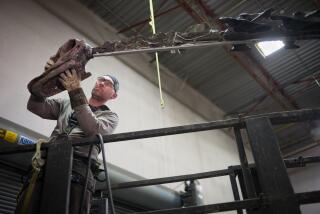A Nose for News About Dinosaurs
- Share via
As the mother of a 3-year-old boy, I was very happy to see a dinosaur on the front page of this and other newspapers last week. For one thing, it provided a great opportunity for me to explain what newspapers are, and why our dining room table is perpetually covered with them. It also lent me a bit of much-needed personal credibility: Yes, Mommy works for this newspaper, yes, yes, the one with the dinosaur on the front.
But this particular item was on the front page for a reason--it was not a benign little story about the discovery of triceratops prints in the silt of Lake Michigan or something neato like that. No, this was about a Big Mistake scientists may have made regarding the size and shape of dinosaur noses.
For a hundred years or so, experts had assumed that dinosaurs were aquatic and so nostrils rode high on dinosaur faces, the better to breathe above water. Now they’ve decided that most dinos were completely earthbound and so their noses were closer to their mouths and less snout-like.
For those billions of humans not directly involved in the making of the “Jurassic Park” film triumvirate, this Big Mistake is not really a Big Deal. Unless, like my family, you happen to own 742 toy dinosaurs. Unless, like us, you happen to own 367 books about dinosaurs. Unless, like us, you happen to own six T-shirts, two sweatshirts and several pairs of long-and short-pants pajamas, all covered in dinosaurs.
Make that now anatomically incorrect dinosaurs.
Anyone who thinks this is not a problem does not have a 3-year-old. Why, just that morning, I had become embroiled in a very frank over-the-potty conversation with Danny Mac about the whereabouts of male dinosaur genitalia. We have a T. Rex hand-puppet who looks very fierce but is actually quite friendly, and my son asked a direct and lucid question about him to which I could only respond, “Ask your Dad.”
Which he did, and Daddy explained, well, yes, sure, T. Rex was fully equipped--how else would little T. Rexes get made? Time out. After much parental huddling, I then explained that our particular puppet had probably just asked the puppet maker to camouflage certain portions of his anatomy since he didn’t have any underpants. Danny Mac seemed satisfied with this, but you can see what I’m up against.
How on Earth am I going to tell him that the faces of his favorite toys are all wrong? How do I explain that those high flaring nostrils are a myth, that most dino noses were small and sort of funny-looking?
My God, has anyone even spoken to Barney?
My husband has suggested that we just don’t mention it, but I believe that secrecy begets shame, and I don’t want Danny Mac finding out something like this on street corners.
Fortunately, there are a few that I believe will survive the transition--the sauropod in “Danny and the Dinosaur” is drawn vaguely enough to pass, and that’s a biggie. In fact, many of the older books are fairly cartoonish; it’s the modern stories, with their hyper-realistic illustrations, that are going to suffer.
Dave Plenn, proprietor of the Dinosaur Farm, a dino-heavy toy store in South Pasadena and its accompanying Web site, was fairly sanguine.
“I haven’t had any customers mentioning it yet,” he said, “not even on the Web site, which is kind of surprising because some of those folks are pretty hard core. But we just got some fantastic new models in the store, and [the news] did sort of wreck it for me. I mean, I look at them now and think, ‘Oh, great, but the noses are wrong.”’
According to Plenn, it will probably be awhile before any new, improved models roll off the dino assembly line. The last Big Correction--that T. Rex did not walk upright and clomp around like Godzilla--was made in the science community about 10 years ago, and it took four or five years for the toy manufacturers, even the really fastidious ones, to finally catch up.
“It’s way too expensive to rush out a new model just because of a nose,” says Plenn.
But books with the appropriate olfactory passages will probably come out in the next year.
Meanwhile, as Plenn points out, the age range with the greatest devotion to dinos is 3 to 6, so it’s unlikely that they’re reading the newspaper.
Unless, of course, some parent is stupid enough to point it out.
More to Read
Sign up for Essential California
The most important California stories and recommendations in your inbox every morning.
You may occasionally receive promotional content from the Los Angeles Times.











